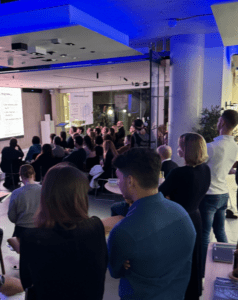On the evening of 20 November, over a hundred lighting professionals gathered in the Atrium LTD showroom in London for an event that illuminated the intricate relationship between lighting and circadian rhythms. The Happy Circadian Hour, a CPD and networking opportunity, offered an array of insights into the current understanding and latest advancements in the field of circadian entrainment.

The event, featuring Dr. Shelley James and co-hosted by designing lighting global (dlg) Publisher Randy Reid, commenced at 18:00 with of drinks and appetizers, setting the stage for an engaging and educational evening. Dr. James, a leading expert in the field of circadian lighting, took center stage at 6:30 PM and captivated the audience with discussions on the known and unfolding science of circadian lighting. She provided an in-depth perspective on how the science of light’s impact on the body clock is accelerating, offering fresh viewpoints on how to leverage this knowledge for practical applications in lighting design.

Following Dr. James’s enlightening talk, a panel featuring industry leaders Ulysse Dormoy of Atrium LTD, Jesse Lilly of LMPG and lighting designer Colin Ball took the discourse further, examining the implications of circadian principles in lighting standards and design practices. Their collective expertise added depth to the conversation, highlighting the diverse ways in which light influences our biological rhythms.

The attendees, predominantly lighting designers from large and small firms, engaged in dialogue where they covered the technical aspects of circadian lighting. They also delved into personal topics, discussing how one’s genes might shape their chronotype and subsequently influence sleep patterns and productivity.
The event concluded with an inventive twist—a creative game that allowed the participants to celebrate their personal Happy Circadian Hour, incorporating the session’s takeaways into a memorable hands-on experience.
As Ulysse Dormoy remarked, the session was not just informative but also a gateway to understanding the potential of lighting to enhance daily life, from optimizing routines to improving sleep and overall well-being.
The experiment aimed to measure lighting designers’ interest in circadian lighting. Based on attendance and engagement, there is significant interest in this field.






